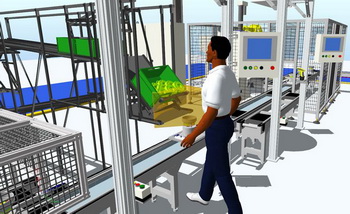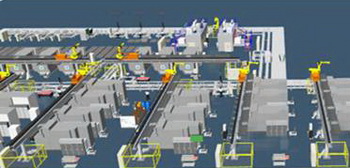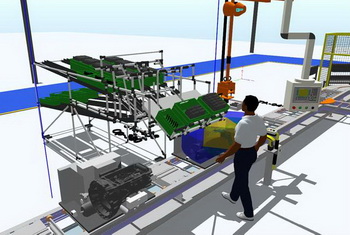

 |
|
It’s been transforming how people watch
movies and TV for years. Now, Fiat and
Chrysler Group are using the world of 3D to
change the way they look at planning for
future products and implementing World Class
Manufacturing before a single machine is
built or installed. |
|
|
|
It’s
been transforming how people watch movies and TV for
years. Now, Fiat and Chrysler Group are using the world
of 3D to change the way they look at planning for future
products and implementing World Class Manufacturing
before a single machine is built or installed.
During a speech at the Management Briefing Seminars in
Traverse City, Mich., on Monday (Aug. 6), Chrysler
Group’s Brian Harlow, Vice President, Head of NAFTA
Powertrain Operations and Global Powertrain
Manufacturing Engineering, said that the company has
brought 3D into its upfront processes in order to
prepare for the launch of two important new
transmissions in Kokomo, Ind., – the eight-speed
rear-wheel drive and nine-speed front-wheel drive – as
well as other new powertrain programs.
“We knew we needed a new way of working in order to get
our plants in Kokomo ready at an accelerated pace,” said
Harlow. “By using 3D technology, we are in effect
injecting the principles of WCM from the very beginning
of our planning for production startups such as the ones
in Kokomo.”
WCM is a rigorous, integrated system that encompasses
all plant processes. The goal of WCM is to continuously
improve performance in order to reach the objective of
zero waste, which includes zero accidents, zero
breakdowns, zero waste of motion and zero inventories.
With the help of Auburn Hills, Michigan-based Strategic
Manufacturing Solutions (SMS), Chrysler Group is
utilising a three-dimensional modelling system
specifically for powertrain manufacturing to help
everyone see the shop floor as it really is and not how
one might imagine it is.
“We live in three dimensions, not two, so with a two
dimensional drawing, you had to imagine the third
dimension,” said Harlow. “Engineers have good
imaginations, but those imaginations don’t all work the
same way. If you have 10 engineers looking at a 2D
drawing, they will all see it a little differently.”
By turning the view, Harlow said that engineers can see
the manufacturing environment, including equipment,
materials and operators, as it really is. In this way,
issues that may delay a program or cost money to fix are
addressed even before the first piece of equipment
arrives at the plant.
“Three-dimensional modelling allows us to make our
actual investments as late as possible in the launch
process,” said Harlow. “The goal is to make the launch
process as vertical as possible because this shortens
the time it takes to recover our investment.”
Three-dimensional layouts are used to help figure out
where racks and materials should be stationed to bring
parts to operators in the Golden Zone, a 60-degree
window that is ideal to present parts. They can also be
used to eliminate conditions on the line that might be
unsafe or could cause injury or strain for the operator.
The software also has the capability of showing an
exploded view of a machine. By de-contenting the
machine, an operator can see all of the nuts and bolts,
making it easier to understand how it goes together,
maintain and repair.
“Animation is another critical aspect of the 3D
programming,” said Harlow. “It allows us to validate
cycle times and to discover system-related issues even
before the machinery is made.
“If there is a situation anywhere that compromises
production, we can identify it up front in the process,
something we ordinarily wouldn’t know until the first
day of production,” continued Harlow. “Now we can be
proactive. We can change cycle times by moving content
or by making changes with the machine tool builder.”
One of the other benefits of the technology is the
immediate information exchange between the plants around
the world, machine tool builders and SMS. Using a
computerized white board, people at the plant can write
directly on layouts, then that information goes back to
SMS where people immediately integrate the changes into
a master layout. At any point in time, those layouts are
available through a remote access system to anyone
anywhere in the world.
Another example of how this software is helping Chrysler
drive waste out of the system is by making it much
easier and much faster to analyse investment costs up
front. A financial calculator takes variables such as
capital investment, capacity, operating budget,
perimeter costs and cost per unit and shows how
they affect each other. Comparisons can be made fast,
side-by-side so informed decisions can be made based on
the financial consequences. “The system that we have
developed while working with SMS allows us to move fast
by pulling the discovery process way forward where we
can address issues before they ever become a problem on
the plant floor,” said Harlow.
ItaliaspeedTV:
Example of 3D
modelling in the factory development process
|
|
|